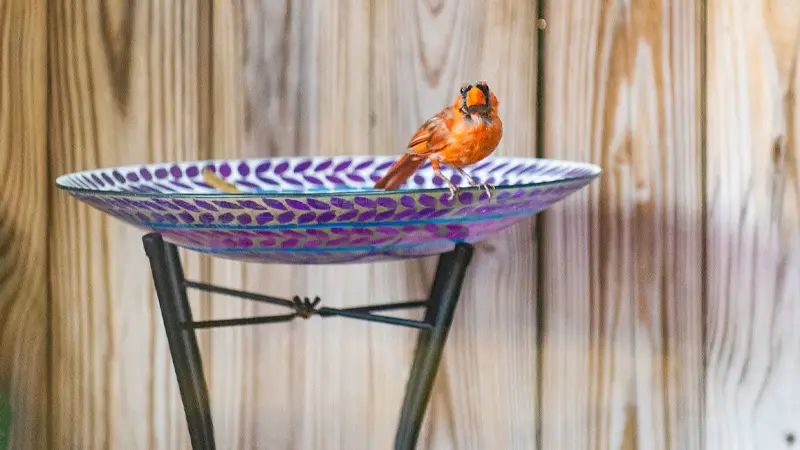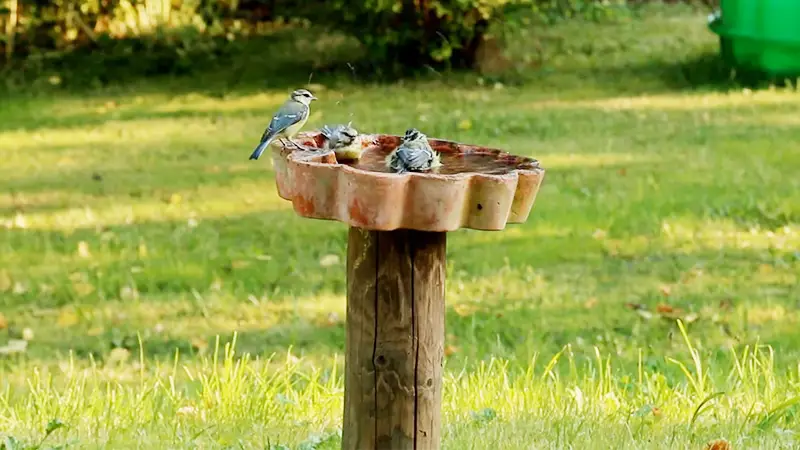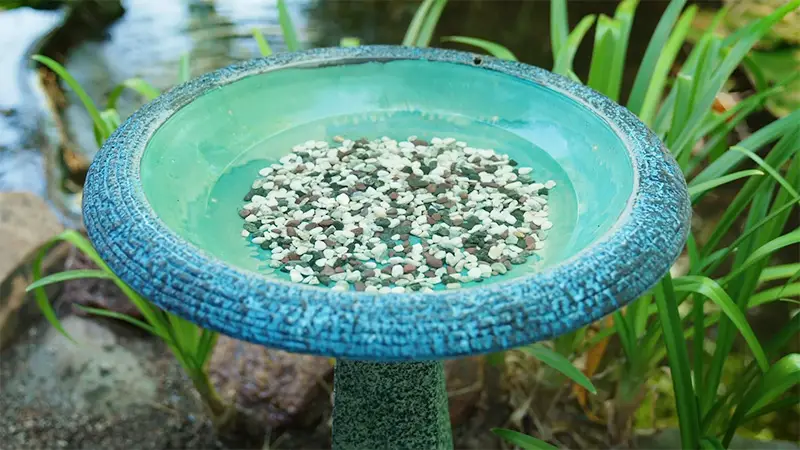Bird baths, those serene additions to our gardens and urban landscapes, provide more than just aesthetic beauty and soothing sounds. These small pools of water play a vital role in supporting local avian populations and fostering a healthier ecosystem.
As we delve into the ecological impact of bird baths, we uncover a fascinating web of connections between these simple structures and the environment around us.
Bird baths serve as oases for birds in search of hydration and bathing opportunities, especially in arid regions where water sources can be scarce. However, their significance goes beyond quenching a bird’s thirst.
These miniature water bodies attract a diverse range of species, from songbirds to raptors, creating hubs for social interaction and breeding opportunities.
In this exploration, we will uncover what’s the ecological impact of bird baths, from supporting biodiversity to promoting pollination. Join us as we dive into the world of bird baths and their ripple effects on the natural world.

What’s the Ecological Impact of Bird Baths?
Bird baths hold a fascinating and multifaceted role in shaping the ecological dynamics of our surroundings.
In this section, we will delve into the ecological impact of bird baths, shedding light on the various ways they influence local ecosystems, biodiversity, and the well-being of avian species.
Hydration Stations for Birds
Bird baths primarily serve as essential hydration stations for birds. In many regions, finding a reliable source of water can be a daily struggle for avian species, especially during dry and hot seasons. Bird baths provide a consistent and accessible water source, addressing this critical need.
Birds not only drink from these basins but also use them for bathing. Bathing helps birds maintain their plumage, remove dirt, and control parasites.
By offering a place to both drink and bathe, bird baths contribute significantly to the overall health of avian populations.
Promoting Bird Diversity
One of the remarkable impacts of bird baths is their ability to attract a diverse range of bird species. These small bodies of water act as magnets, drawing in birds from various habitats.
Whether you live in an urban area or the countryside, you’re likely to observe a wide array of birds congregating at your bird bath.
This diversity of avian visitors can be attributed to the universal need for water. Birds of all sizes and species require water to survive, making bird baths an inclusive resource for the avian community.
The presence of different bird species in your garden or yard can be a source of wonder and delight, as you witness the colorful plumage and distinct behaviors of various birds.
Social Hubs and Learning Centers
Bird baths are not just about hydration; they also serve as social hubs for birds. They become gathering places where birds of the same species and even different species interact. These interactions are not merely casual; they are important for the birds’ social learning and communication.
Young birds often learn important skills and behaviors by observing older birds at bird baths. It’s a bit like a classroom where avian knowledge is passed down from generation to generation.
This social aspect of bird baths is a testament to the interconnectedness of avian communities and the vital role these watering holes play in their lives.
Breeding Opportunities

The presence of bird baths can also enhance breeding opportunities for local bird populations. As birds gather at these watering holes, they not only quench their thirst but also engage in courtship rituals.
Bird baths can become focal points for mating displays and courtship behaviors, ultimately leading to successful breeding.
Moreover, birds are more likely to choose an area for nesting if it provides a reliable source of water. Bird baths, in this sense, contribute to the reproduction and expansion of avian species in the vicinity.
By maintaining bird baths in your outdoor space, you may inadvertently be supporting the growth of local bird populations.
Controlling Insect Populations
Birds are voracious insectivores, and their presence around bird baths can help control insect populations in your garden. Insects are a primary food source for many bird species, and the proximity of bird baths to gardens creates a natural pest control system.
As birds visit bird baths and forage nearby for insects, they help keep insect populations in check. This can reduce the need for chemical pesticides and promote a healthier and more balanced ecosystem within your garden.
Facilitating Pollination
Some bird species, such as hummingbirds, are important pollinators. Bird baths can attract these tiny marvels of nature. While they primarily feed on nectar from flowers, they also need water for hydration.
By providing a bird bath, you may entice hummingbirds to visit your garden, contributing to the pollination of plants and flowers in the area.
The role of hummingbirds in pollination cannot be underestimated, as they transfer pollen from one flower to another, aiding in the reproduction of numerous plant species. Thus, bird baths indirectly support plant life and contribute to the overall ecological balance.
Challenges and Responsible Bird Bathing
While bird baths offer numerous ecological benefits, there are some challenges associated with maintaining them. It’s essential to keep bird baths clean to prevent the spread of diseases among birds.
Stagnant water can become a breeding ground for harmful microorganisms. Regular cleaning and refreshing of the water are crucial to ensure the well-being of both birds and the environment.
Additionally, bird baths can sometimes attract unwanted visitors such as mosquitoes. To mitigate this, consider adding a small solar-powered fountain to keep the water in motion, making it less hospitable for mosquito breeding.
How to Maintain Bird Bath Hygiene?

Maintaining proper hygiene in your bird bath is crucial to ensure the health and well-being of visiting birds while preventing the spread of diseases. Here are some essential tips to help you keep your bird bath clean:
Regular Cleaning
Cleaning your bird bath should be a routine task. Ideally, clean the bird bath every two to three days, especially during warm weather when algae and bacteria can thrive. Use a scrub brush or a bird bath cleaning brush to remove debris, algae, and any bird droppings.
Use Mild Cleaning Agents
Avoid using harsh chemicals or detergents when cleaning your bird bath. These can be harmful to birds and the environment. Instead, opt for mild, bird-safe cleaning agents such as white vinegar or a diluted bleach solution.
A mixture of nine parts water to one part bleach is generally safe when thoroughly rinsed.
Rinse Thoroughly
After cleaning with any cleaning agent, make sure to rinse the bird bath thoroughly with clean water. This step is crucial to remove any residue of cleaning agents, which could harm the birds.
Scrubbing
Use a scrub brush to clean the surface of the bird bath thoroughly. Algae and other contaminants can accumulate on the surface, making it slippery and unsafe for birds. A gentle scrubbing will help remove these deposits.
Change the Water Regularly
Stagnant water in a bird bath can become a breeding ground for mosquitoes and other pests. To prevent this, change the water in your bird bath every one to two days. Fresh water not only keeps the bath cleaner but also provides a clean drinking source for birds.
Consider a Fountain or Dripper
Bird baths with moving water, like fountains or drippers, are less likely to develop stagnant conditions and are often more attractive to birds. The motion of the water also inhibits the growth of algae and keeps the water fresher.
Positioning
Consider the placement of your bird bath. Shaded areas may accumulate less algae and require less frequent cleaning. However, avoid placing the bird bath under trees where falling leaves and debris can quickly dirty the water.
Seasonal Maintenance
In colder climates, bird baths may freeze in winter. Consider investing in a heated bird bath or a de-icer to provide birds with water during freezing temperatures. Be sure to clean these devices regularly as well.
Bird Bath Accessories
You can add certain accessories to your bird bath to help maintain its cleanliness. For example, using a bird bath protector or water agitator can reduce the buildup of algae and debris.
Be Mindful of Surroundings
Keep an eye on the area around your bird bath. Overhanging branches can drop leaves and twigs into the water. Trim these branches to reduce debris falling into the bath.
Monitor Bird Health
Keep an eye on the health of the birds that visit your bird bath. If you notice signs of illness or abnormalities in the birds, it may be an indication of poor water quality or contaminated water.
In such cases, temporarily suspend the use of the bird bath until you can clean and sanitize it thoroughly.
By following these hygiene practices, you can ensure that your bird bath remains a safe and inviting place for birds while contributing to the well-being of your local avian community.
Remember, a clean and well-maintained bird bath not only benefits the birds but also enhances your enjoyment of the natural world in your own backyard.
FAQs
How often should I clean my bird bath?
It’s recommended to clean your bird bath every two to three days, especially during warm weather when algae can grow quickly. Regular cleaning helps maintain water quality and prevents the spread of diseases.
Can I use dish soap to clean my bird bath?
It’s best to avoid using dish soap or other detergents, as they can leave residues that are harmful to birds. Instead, opt for mild cleaning agents like white vinegar or a diluted bleach solution, followed by thorough rinsing.
Why is it essential to change the water regularly?
Changing the water every one to two days prevents the accumulation of contaminants, mosquito breeding, and the growth of algae. Freshwater ensures birds have a clean and safe drinking source.
What can I do to prevent algae growth in my bird bath?
To inhibit algae growth, place your bird bath in a partially shaded area. You can also consider adding a water feature like a fountain or dripper, as moving water is less conducive to algae growth.
Are heated bird baths necessary in winter?
In colder climates, heated bird baths or de-icers are helpful to provide birds with water during freezing temperatures. It’s important to clean and maintain these devices regularly to ensure they function properly and provide a water source for birds in winter.
Conclusion
The ecological impact of bird baths is far-reaching and multifaceted. These seemingly modest additions to our outdoor spaces play a crucial role in sustaining local bird populations and enhancing overall ecosystem health.
Bird baths provide a dependable source of hydration and bathing for birds, especially during hot and dry seasons. They also serve as meeting points for various bird species, fostering social interactions and aiding in the dispersal of vital ecological information.
Furthermore, the presence of bird baths in our gardens and urban environments encourages biodiversity by attracting a wide range of bird species. This, in turn, can have cascading positive effects on the ecosystem, from controlling insect populations to facilitating pollination.
As we appreciate the beauty and tranquility that bird baths bring to our surroundings, we must also recognize their significant ecological contributions.
By maintaining these simple yet impactful features, we can actively participate in supporting local wildlife and promoting a healthier, more balanced natural world right in our own backyards.